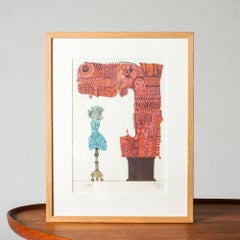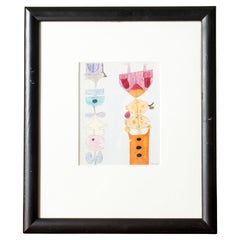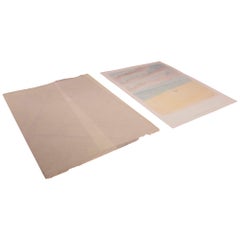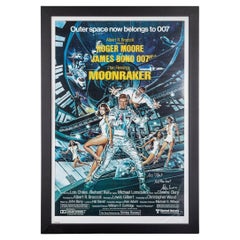Stig Lindberg Decorative Art
to
2
2
Height
to
Width
to
2
2
1
1
1
1
2
2
2
2
2
2
2
2
114
379
247
238
94
Creator: Stig Lindberg
Scandinavian Modern Litography by Stig Lindberg, Sweden, 1979
By Stig Lindberg
Located in Stockholm, SE
Lithography by Stig Lindberg, number 90 of 200, with a striking abstract motif of a female figure and a dragon. Colorful and elaborate in Lindberg’s distinct style. Mounted in an oak...
Category
1970s Swedish Scandinavian Modern Vintage Stig Lindberg Decorative Art
Materials
Wood, Paper
Scandinavian Modern Gouache by Stig Lindberg, Sweden, 1950s
By Stig Lindberg
Located in Stockholm, SE
Gouache by Stig Lindberg, with a motif of faces, a building with a drainpipe and graphic floral forms. Colorful and playful in Lindberg’s distinct style.
Measurements are including ...
Category
1950s Swedish Scandinavian Modern Vintage Stig Lindberg Decorative Art
Materials
Wood, Paper
Related Items
HERMES 2000 for Sempé- Litography "Premiers Pas dans le Siècle"
By Hermès
Located in Marbella, ES
HERMES 2000 for Sempé- Litography "Premiers Pas dans le Siècle"
Category
Early 2000s French Stig Lindberg Decorative Art
Materials
Paper
$1,083
H 15.36 in W 11.82 in D 0.04 in
Original James Bond 007 'Moonraker' Film Poster, Signed by Roger Moore, c.1979
Located in Royal Tunbridge Wells, Kent
A very rare and original British (UK) release poster from the blockbuster Moonraker (1979), signed by Roger Moore. This was the eleventh in the James Bond series produced by Eon Prod...
Category
20th Century British Stig Lindberg Decorative Art
Materials
Paper
$4,936
H 39.38 in W 27.17 in D 1.19 in
1979 Hutschenreuther Wall Plate by Ole Winther Zodiac Decor, Ltd. Edition
By Ole Winther, Hutschenreuther
Located in Andernach, DE
A wonderful square shaped wall plate from 1979.
Original by Hutschenreuther, the design: Ole Winther, with signature on the front & back.
Porcelain, limited edition of 3000 plates o...
Category
Mid-20th Century German Mid-Century Modern Stig Lindberg Decorative Art
Materials
Porcelain
$162
H 0.99 in W 11.62 in D 11.62 in
18th Century Swedish Gustavian Pinewood Wall Glass Mirror - Scandinavian Décor
Located in West Palm Beach, FL
A late 18th Century, antique Swedish Gustavian wall mirror made of hand crafted Pinewood with its original mirrored glass, in good condit...
Category
18th Century Swedish Gustavian Antique Stig Lindberg Decorative Art
Materials
Pine
$5,900
H 24 in W 11.5 in D 1.25 in
Swedish Modern Tapestry "Nattviol", Butterfly Orchid by Märta Måås Fjetterström
By Märta Måås-Fjetterström, Märta Måås-Fjetterström AB 1
Located in Stockholm, SE
Swedish modern tapestry. The pattern is called "Nattviol" (Butterfly Orchid) and is a part of the series "Juniblommor" (Flowers in June), composed 19...
Category
1940s Swedish Scandinavian Modern Vintage Stig Lindberg Decorative Art
Materials
Wool, Linen
$4,575 / item
H 15.36 in W 15.16 in D 0.2 in
Scandinavian Modern Wall Plaque, Heinz Erret, Gustavsberg -1970's
By Gustavsberg, Heinz Erret
Located in Örebro, SE
Scandinavian Modern earthenware wall plaque, Heinz Erret for Gustavsberg, 1970's. Silver inlays, dark blue glaze with decoration from Småland's landscape flower.
Signed with makers m...
Category
1970s Scandinavian Modern Vintage Stig Lindberg Decorative Art
Materials
Earthenware
Painting by Marcel Delmotte Entitled "Le dialogue du silence", 1979
By Marcel Delmotte
Located in Saint-Ouen, FR
A painting by Marcel Delmotte entitled "Le Dialogue du silence".
Unique piece.
Good conditions.
Sold with the original frame,
1979.
Dimensions :
Without frame / 90 x 120 cm / 3...
Category
20th Century French Beaux Arts Stig Lindberg Decorative Art
Materials
Paint
$17,950
H 35.44 in W 47.25 in D 3.15 in
Christmas 1979 Wall Plate by Wiinblad, Hand Painted Gold Porcelain, Rosenthal
By Bjørn Wiinblad, Rosenthal
Located in Andernach, DE
Bjorn Wiinblad, Danish artist, has created this beautiful series for German art glass & porcelain makers Rosenthal for their Studio-Line art edition.
This plate is the 1979 edition, ...
Category
Mid-20th Century German Mid-Century Modern Stig Lindberg Decorative Art
Materials
Porcelain
$313
H 0.63 in Dm 11.23 in
Large Mid-Century Scandinavian Modern Wall Plate, Nittsjö Sweden
By Nittsjo Keramik
Located in Skarpnäck, SE
Mid-century modern signed Scandinavian art pottery wall decoration, which can also function as a large plate or bowl. This piece is known as “the Peacock” and has a very 70's feeling...
Category
1960s Swedish Mid-Century Modern Vintage Stig Lindberg Decorative Art
Materials
Ceramic, Stoneware
Ten Wall-Mounted Candle Holders by Pierre Forsell, Sweden 1950s
By Pierre Forsell, Skultuna
Located in Copenhagen, DK
Pierre Forsell & Skultuna - Scandinavian Modern Design
A beautiful and decorative set of 10 wall-mounted candleholders, Pendal no 71, by Pierre Forsell.
Made by Skultuna, Swede...
Category
Mid-20th Century Swedish Scandinavian Modern Stig Lindberg Decorative Art
Materials
Brass
French 1950s Enamel Sign
Located in Brecht, BE
These enamel signs were used nearby schools, great decorative object, collector’s item.
Category
Mid-20th Century French Stig Lindberg Decorative Art
Materials
Enamel
Scandinavian Modern Candle Sconce by KONRAD GALAAEN (1923-2004), c. 1960/70s
By Konrad Galaaen, Porsgrund Porselænsfabrik
Located in Skien, NO
**Mid-Century Porcelain Sconce by Konrad Galaaen for Porsgrund, 1960/70s, Norway**
A stunning candle sconce by celebrated Norwegian designer Konrad Galaaen (1923-2004) for Porsgru...
Category
Mid-20th Century Norwegian Scandinavian Modern Stig Lindberg Decorative Art
Materials
Metal
$600
H 12.8 in W 6.3 in D 5.52 in
Stig Lindberg decorative art for sale on 1stDibs.
Stig Lindberg decorative art are available for sale on 1stDibs.
Recently Viewed
View AllMore Stig Lindberg Furniture
Stig Lindberg Wall-mounted Sculptures
Stig Lindberg Decorative Objects
Stig Lindberg Serveware, Ceramics, Silver and Glass
Stig Lindberg Lighting
Stig Lindberg Tables
Stig Lindberg Mirrors
Stig Lindberg Asian Art and Furniture
Stig Lindberg Vases
Stig Lindberg Decorative Bowls
Stig Lindberg Decorative Dishes and Vide-Poche
Stig Lindberg Bottles
Stig Lindberg Planters, Cachepots and Jardinières



